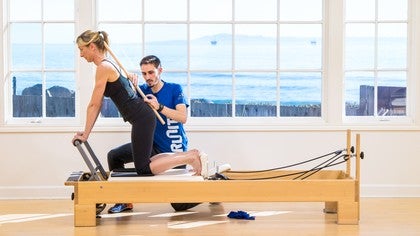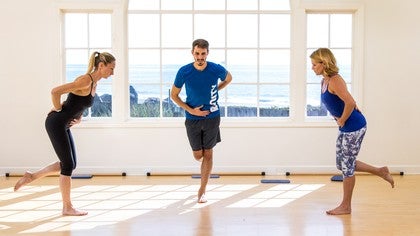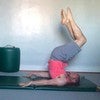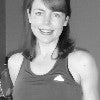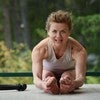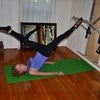Description
About This Video
Transcript
Read Full Transcript
Hello, my name is Juan. Juanito. I'm here to share with you a standing class, a leg work class, that works for runners. Actually for every human, and if you're a human, you're a runner. So that's basically the same thing. It's going to be, like, a standing and a kneeling class.
We're going to work on the stability, on the frontal plane. Ability to control our movement. I hope you like it. You can modify it. We're gonna use little sticks if you need, and I will give you some tools and some help you know, if you do it at home if the level is too complicated for you.
So let's get us started with a little bit of assessment. Just to check where are you. And it's good that you can do this at your home. So we're gonna stand up on the right leg, and we're gonna make a single leg stance. And keeping your body vertical, let's try to do, like, a little knee dip.
All right? So your chest is up, and then you go down and up. The idea is that, is the knee is going forward. It's moving forward, and it's crossing, like, 1.5, two inches over the longest toe. Then we'd be, like, okay, I'm ready to do this.
If not, we will to work a little bit earlier this class, but at least, you need to have this control in order to make sure that this class is gonna benefit you. So let's try the other one, so we're gonna stand up vertical, and we're gonna do the knee dip. We're gonna try to take the knee as forward as we can. And actually, we need some room into the ankle joint. So the knee is going forward, couple of inches in front of the longest toe.
Okay, let's do it again. So, it's okay if you stumble a little if you wobble a little. It's completely okay. It's just a matter of keep practicing and exploring the movement. But it will get better.
And this class is going to help you. So let's warm up. We're gonna do this step position. Make a comfortable step, both feet are pointing forward, and I want you to take your hands on the sides of the bellies, all right? So what we are going to do is to move forward and, because of the position of the feet, the bellies is going to drive to the side.
All right? So I want you to really go forward and allow the pelvis going to the side. When you go there, you go very deep into a hip circuit. You will start lubricating and creating some sort of rub reception into the hips. And you probably, if you touch the lateral part of the hip, it will be some sort of engagement, like, the muscle is reacting, it's recruiting.
So that's fine. It's what we want. We want to wake him up. And then we are gonna take our weight back. So we're really going to go deep into the hips.
So you feel that the muscle is kind of engaging in an automatic way. So that's cool. And then we move forward. So this is just to wake up hips, to wake up the joints, but I want you to have this dip feeling into the hips, that's it. And the pelvis is moving, kind of, forward and backwards, okay?
Even though you see it as diagonal. That's okay. All right. So, from here, we can create some rotations. So we are just, feet in front of us, we're gonna take the same hand of the feet in front of us, and we are going to rotate to that side.
So the position of the legs are gonna block the lumbar somehow and the pelvis, so it's gonna take that movement more into the thoracic spine. So we're gonna create a little bit of rotation there. So even though this exercise can look, like, very, very easy, it's not that easy 'cause it really goes into the point we want to, we want to work. And from there, we're gonna change, like, 90 degrees, the back foot. Perfect.
And now, what we do is we are going to create some sort of rotation over this foot. So facing this side, in my position, facing this side, we're gonna roll to the other side. So we're gonna create this movement. So now, the front foot, it's, on the front leg, sorry, it's stable, and we are rotating our pelvis over the heel. So, again, if you go and touch your glutes, you can now see that there is some sort of automatic engagement.
So this is what we want. And we want to wait them out. So this is a very nice, 3D warmup that is going to help you to prepare the class, okay? And it's very simple to do. So simple things are good to do at home.
So let's do the other one. So left foot, or the other foot, in front. Right foot behind. You take your hands to the sides, and then you go forward, your intention is going forward even though the pelvis is moving to the side, okay? So you just want to keep the ASIS forward, and then go back and really go deep until you feel that the glutes are kind of holding and controlling the hips, so we go forward, and we go back.
We go forward, that's it. So let's do, like, four or five times. You can do it more if you like. It feels good. And this is interesting.
The more you move the hips, the less you need to move the lumbar. So if you see a lot of movement in the lumbars, it means that the hips are not moving that much. So the lumbars have to create some sort of situation, but we really want just a little bit of stiffness that's natural. I don't want you to hold, I don't want you to engage anything here. You just feel, or have some sort of perception of that the movement is not from the lumbar.
Okay. So, from there, this hand, the same as the front foot. And we are gonna just create some sort of rotation. And believe it or not, this hip is working too because it needs to control the movement from the trunk. So it's a very nice thing to get you to start with.
And then 90 degrees on the back foot so the pelvis is facing, now, this direction. And what we do is with this fixed point, we are going to rotate all the way into the front foot and back. So it's the pelvis that is moving. So it's here. It's our center of gravity.
S2 that is really moving, so we don't wanna drive from the shoulders, we don't wanna drive from the ribs, we want to have the pelvis and the hips moving forward into this position. It's important that the sole of the foot is pretty stable. So it's the only thing that is not changing is the sole of the foot and the front foot. Okay? That's it.
Perfect. Okay, so, we're gonna do a little lunge position, and we are going to sit. So this is the exercise. We're gonna use this rotation to challenge a little bit more. We are going to use a little much for the knees because, sometimes, it's necessary, so I'm gonna give you, or you can take it, thank you.
So. I think one's gonna be okay. All right? So, from here, let's go to the same step as before. Let me take this back, sorry.
All right. And, keeping our body vertical, we're gonna lower our knee like this, okay? So if you need to adjust your distance, you can do it. So feel comfortable in the front foot. The thigh is vertical, and the trunk is vertical.
Okay? So we're gonna do this, like, two or three times. It's very important, now, when we go up, is that the heel is going down, and the hips are extending. So this is driving us forward. Okay, I don't wanna see this.
I wanna see that movement. Beautiful. Okay? So the same idea, we go vertical down. That's it.
And driving from the heel, we go up, and we're gonna go down, perfect. We go again. Good. That's it. That's it. So, now, we're gonna take, that's it, let the knee down.
Now we're gonna lower the toes. And, from here, make sure that you have a stable position in the knee. We are going to rotate 90 degrees as before. But now in a kneeling position. So we are going to rotate here.
That's it. And we are going to sit. All right. Be careful if the knees are a bit unstable, if you have some sort of meniscal issues, or you know that your knees are cracking and popping all the time. Maybe this is not the best exercise for you.
It's good for strengthening the knees, but you have to make sure that your knees are not gonna be swollen or irritated because of doing this. So be careful with this kind of exercise. Now, we're going up. But we're going up, not from the shoulders, we're going up from the hips. So, again, we want to extend the hips like some sort of the feeling into the bridging exercise.
So we go up. That's it. And then we need to rotate 90 degrees as before. All right. I know.
It takes a couple of time, but this is completely normal. It's okay. All right. All right, so. Up.
I would keep it that way. So let's do it again. So, one, shoulders down. Then 90 degrees. And then we sit.
And then, from the hips, we're going up, and then we rotate, and then curl the toes down. And then we're going up. And let's do it again. So, down. Toes down.
90 degrees. Then just sit from the hips. That's very important. And now from the hips, up. And now we rotate again.
Curl your toes down. And then we're going up. Okay? So that's the first exercise. We're gonna do the other leg. All right?
So if you wanna check where is the position first. Could be a nice idea to do. And then we go with standing. All right? So, from there, open the hips, open the chest.
This big, kind of, upright. And then we're gonna take the knee down. We release the toes. And then 90 degrees. And then we sit into the hips.
And then from the hips, forward. And, again, it's this hip that is helping us to rotate. Curl your toes down. And up. And again.
One, toes, rotate, sit, hips forward, rotate, down, and up. Okay? One more time. And we're gonna add something different now. So toes down.
90 degrees. And then we sit. Okay, so now, very interesting exercise to wake up the glute muscles and the pelvic muscles again, so, I want you to rotate to the knee that you have in front of you. And I want you to put the sternum over the knee. All right?
And I want you, not completely rest, but it's kind of a resting position. You don't really need to hold with your arms. You are a little bit supported, but not too much. Okay? So what I want you to do. I don't know if you can see it.
I want you to elevate the foot, doing an internal rotation from the hips. All right? So be sure that you're not moving the trunk, that the torso is stable. So what you do is, you do big internal rotation. Okay? Once you have done it two or three times, you'll probably feel the posterior fibers of the glutes and the anterior fibers of the TFL gluteus minor.
And then we're gonna do the opposite. We lift the foot on the floor and then we lift the knee. So even though it looks like a very, very exercise, you probably will notice, you will definitely notice it. How the glutes are working. It is very important that you have this awareness here in the torso that it's not moving.
So if you see that the movement is happening in the torso, that means that the glutes are made un-efficient now. So you want to keep the trunk really, really stable. And make the movement as big as you can, as large as you can. Do it a couple of times, and do it at your own rhythm. It is very important that you try to give the torso a sense of authority.
Okay? Good. Perfect. So, let's stand up to the mermaid position. It feels really good.
It's a very nice way of activity in the glutes without forcing it. It just happen because everything is locked, everything is limited, so the only possibility to rotate the hips is from the glutes. So that's something that is interesting to do. Okay, so we're gonna change to the other leg. We have a lot of opportunities to do it.
We're gonna try to do it, today, without our hands. So what we do, is we switch to this side. Okay? Again, be careful if you know that your knees is a bit, are a bit unstable. Be careful with this kind of exercise because it is, it implies a lot of rotation. Doesn't mean they are bad exercise for the knee, quite the opposite, but be careful if your knees are unstable now.
So let's do this a couple of times. Try to be as upright as you can. Good. And, again, you are moving and preparing the hips quite a lot here. Feels nice. Sometimes it'll be challenging.
Yeah. They stay on this end. So we change to the other leg. You're gonna take the torso, the sternum over the knee. A little bit of support here.
And then we're gonna start as before with an internal rotation of the hips. And then, we'll lower the leg again and internal rotation at the hips. Perfect. So try to find your end range of functional movement there to really challenge the range that you don't have. The range that you don't have is the range that you really need to work on. So it's very important that you try to get a little bit more every time without letting the muscle to cramp.
So, again, let the feet down. And without moving the ribs, make the external rotation with the hip. The knee is going up and out, and you release in a controlled way. All right? It's important that you keep it.
So even though it looks like an easy exercise, you'll probably see us even shivering in the muscle. That means that we are exploring a new range of motion in an active way. So that's pretty cool for the hip muscles. Okay, we can do four or five repetitions of this, and it's a great movement. Okay.
So now, we stand up. And then, we come here. Again, different possibilities of standing up. Let's try not to use the hands. That could be a possibility.
Let's cross one of the legs and then try to move forward from the hips. And then we stand up. Yeah. Voila. Great.
Perfect. Okay. So now we are to the real thing, all right? So let's try to work on our frontal plane control, transversal plane of control. We're not gonna need this anymore.
So the first exercise is a preparation exercise. But it could be, also, very challenging sometimes. So let's take the feet together. All right? So open your hips.
Extend your spine. Release your shoulders. And now, we can now squeeze one knee against the other one. Okay? So just this exercise here.
What I want you to feel is that you hinge back from the hips. And remember, the hips are here in the groin. The femoral heads are here. And then we go forward. That's the first exercise I need you to understand.
So the idea is not that you move forward. The idea is, like, the hips are going back, back, back, back. And then you extend. All right? It's very nice if you have one of your hands in front of the pelvis and the other one on the lumbars.
So as you can track, you can control if there is too much movement there into the lumbar spine. So we don't really want to have a lot of movement or no movement into the lumbar-, so we hinge back. It's very important that you focus on the big toe and the big metatarsal or phalangeal joint in the right foot if it's the foot that you have on the floor. Because that foot is going to provide you the stability that you need. So we can do, like, four to six.
And you'll probably feel, right? How it is working. Okay. So let's do the other one. Okay. So single leg.
Let's kind of squeeze a little bit the legs, pelvis, and lumbars, and you hinge back. That's very important. You don't want to hinge forward. You really want to take the pelvis behind the heel. All right? Good.
Back, back, back, back, back, back. Keep squeezing. That's it. And it's very important trying to control from the big ball and the big toe. The big ball is the anchor for movement.
Let's do it one more time. Relax. Good. Perfect. So let's try to progress.
Are you okay? All right. The muscles are waking up royally. So that's good. So now, pinkie finger to the little toe.
This is what, now we have to put it in our heads. What I want you to do is try to create the same idea of motion. Now you can bend the knee a little bit if you need. But keeping the spine stable, what I want you to do is that you touch the little toe with the little finger, okay? So the idea is that you hinge back to create a little bit of support from the hips, and then you go up.
So the spine is kind of upright. And then you hinge back. Go deep into the socket of the hip. Oops. And do it again. Awesome.
Okay. And two more times. Go deep. From the hips. Feel the big ball.
It's completely normal if you stumble, we're humans. We need to learn this. And, actually, in that process, is where we really progress, where we really learn. Okay? If everything's perfect it means that we're not learning anything.
So that's quite boring. Anyway, let's go to the other foot. Pinkie finger, little toe. Again, we go deep. Very, very, very deep.
That's it. And then we try to touch and extend. And again. Just open. Little finger to little toe.
And even more important that the exercise is perfect, I like to see some sort of ease, some sort of organic movement. Just not a lot of rules. It's not straight exercise. It's more movement. It's an exploration. Okay.
Let's complete the knee extension. We do it again. We go up. All right, let's shake it. It feels like they're starting to work, right?
Okay, that's cool. Cool, cool. Okay. Let's continue this process. Now we're gonna play with reciprocal motions where one of the hips go into flexion and the other one is doing extension. So it's very cool for the hips, so.
Upright, feet together, parallel, pointing forward. We're gonna take the left knee up, and we're gonna hold it. And we're gonna try to take them, take it, sorry, as close as you can to the chest. So, very good posture, going up. So, from there, I want you to hinge back again as we learned before, and I want you to lengthen your back leg and lengthen your arms.
Kind of the same line, okay? You can bend your knee. Feel the weight in the big ball. And now, from the hips, you go up. Beautiful.
You're doing great. And we go into flexion. So now we're challenging, through this, the end range flexion of this leg, and I want you to extend this knee. Really, really, really extend it to open the hips in the right side. And then we hinge back.
Beautiful. Sorry. And then we extend. And we lengthen. Extend the knee that is in the air.
Lengthen the arms. Extend the thoracic spine. Beautiful. And then, from the hip, we do it again. Okay?
So it's okay. We're gonna do more. As far as you doing this class, but two is a nice number. So let's release this. And let's do the other one, the other side.
All right, so, that's it, so, lift, control. We go with the right hip in flexion. We extend the left leg. And now we hinge back. Perfect. Keep the chest open.
And when you feel that you cannot go any further, you extend the leg. You extend the arms. You try to control on the ball of the big, of the left foot. And really extend the flying leg. Extend it, extend it, extend it.
Extend the thoracic spine. Keep it a few seconds. And now, from the hips, you open the hips, and then you go into flexion again. Going up, up, up, up, up, up, up. Shoulders back.
And a little bit lower. Feel the flexion. Now hinge back. Keep this open. Now we lengthen.
We go very deep here into the groin. I want you to feel that the glutes are holding your femur. So really extend. Feel the big ball, feel the foot working, and then we go up. And then, that's that.
Good, that was very good. Okay, let's shake it a little bit. All right. So now we're gonna do a series of lunges exercise. We're gonna go forward, backwards, to one side, and to the other side.
Like, kind of around the clock or around the world. Like Gladys said. So, but, we're going to break it up a little bit. Okay? Before going through the whole series. Right. So, the front lines is classic exercise.
So we are gonna try to keep our torso upright, and it's very important for me that you understand that the movement starts from the hips, from the center of gravity. Some people do like this to do the lunge, but what I want you to feel is that pelvis going forward and then back. Okay? So the whole movement starts from here. So we are kind of falling forward from the hips.
And when you feel that your weight is over, then you use your leg, and then you go back. Okay, so let's do it again. Forward. We're gonna do five. So one.
And two. And it's important that you roll on the first empty bill, the metatarsal phalangeal joint, the big ball, and that you try to keep the heel over the big ball. This is the fourth or the three? Okay, sorry. Okay, let's say this is the fifth.
Okay. Five. Yeah. So when you do the exercise, you roll on the ball of the big toe, and the heel is straight up into the ball. Okay? So you really wanna see, that's it, that the heel is going out or in.
That's it. And I want you to really go and press there 'cause you're gonna feel that connection. So the big toe and the glutes really relate to each other. They target each other. And now, I want you to drive, as before, with the heel back, and the belly's back.
Okay, thank you. So we're going to do the squats. So you can come closer. So now, there's the pelvis, going back. And forward.
So, back, big ball, forward. Now it's important that we spread the weight in both legs 'cause, later, we will do something a little bit different, but this is in both legs. So we go vertical, and our weight is in the middle of the two feet. And again. Important to keep the heel over the big ball.
Last one. And that's it. So that would be the front lunge, the back lunge, the forward lunge, or the backward lunge. You can do it as intensive as you wanna do it. If you wanna do, like, 30 seconds, very intensive.
Why not? But now, it's more like a movement exploration to really understand what happens in our body. Okay? So the next exercise is gonna be a, like a lateral squat. This is gonna be, like, quite big and ranged movement.
I really want you to explore end range of movement in through the frontal plane. So now we're going to open the legs. At the beginning, it's gonna be parallel, so it can be wide open. So, we are going to start on the right leg, all right? So the right foot is gonna be a little bit forward, like, half a foot.
All right. And you can turn it a little bit out, not too much. Just a little bit. Okay? The left foot is facing forward.
And this is very important. We're going to try to keep it really, really flat on the floor all the time. So we don't wanna twist it. We want to work with the foot. That's it.
Keeping it really down into the floor. Okay. So what we do is we go down as far as you can. And then you go up. Okay?
So, go dip. Try to keep the other one. And then you go up. This exercise is really good to start load in. The leg muscles is more load, so it's harder work.
And at the same time, you're working on the lengthening and the extensibility of the tissues in the other leg. And you feel that, right? So feel that you are kind of creating some sort of tension in your other leg, so you can bounce back. So you can juice that tension to come back. So let's do it once again.
And that's it. Perfect. So shake it if you need. Let's do the other one. All right? So. Quite wide step.
At the beginning, it's parallel. Now it's the left foot. You go a little bit forward. You turn it out if you need a little bit. That's it.
And what you do is you keep the other foot really, really stable on the floor so the sole of the foot is not changing. And then you go, dip. And up. It is normal that there are some sort of adaptation in the trunk. But you're doing very good.
So you can see very different levels here. And it's good to see. It's normal. Every one of us has a different approach of doing this. Last more time.
Grill it in. Beautiful. And, again. All right, so now, just shake it a little bit. Okay, so we have the forward, we have the backwards, we have the sides, and now, we're gonna do, like, a partial or the beginning of the, what is it?
It's called the traveling squat? Okay. So the travel squat, it's crossing. And then, when we cross, we go down. Okay?
So we go up. And then let's do the other side. So we cross, and then we try to control the movement, try to control the feet. Then we go up. It's very important, again, that you look, or you try to move from the hips, from here.
That's it. One more time. And, okay, I think you got it. I'm excited for the next step. So, now, around the world.
Forward, side, backwards, travel squat. Okay? So let's do two, three of them. Let's see how it works. If I can't keep from talking, we stop.
So let's do a couple of them, all right? So make sure you have space. So front with the right. And back, to the side. Here.
That's it. And backwards. Okay. And forward, and now traveling squat. So here, all right.
So this is the first. Second, a little bit more easy. Even though it's not perfect, I want you to kind of figure out the starting movement, okay? So, one. And two.
And three. And four. That's it. And one. And two.
Three. And travel squat. Good, beautiful. One more time. Now, let's do it.
It's Halloween. One. Supposed to be scary. Two, hey. Backwards.
And travel. Oh, yes. All right. Let's do the other one. Left side, okay.
That was fun. So, good posture, feet facing forward, extend your hips, and now, you go. Forward, to the side. That's it. And back.
Backwards. And traveling squat. And forward. This feels easier probably for you? Yeah.
Up, and traveling. Okay. We keep focused, even though, let's do another one. Even though the exercise is kind of challenging, we keep focusing on the quality and the control of the movement. Without creating a lot of rigidity in it.
All right? So we keep the possibility of having fun and enjoy. But understanding that we are trying to work on the quality of the movement. All right. So, again, we can do this as challenging and intensive as we want, but just start this, like, three or four reps, to explore it.
To see what happens next day. How is your muscles responding. And if the load is okay, you can keep moving. All right, so, now we're gonna do a little preparation of another squat that's a bit more challenging. It's called a shrimp squat.
But we're gonna just do the first part of it. So it's a step back lunge. So we're gonna keep the weight on the right foot. So the idea is we make a very short lunge. Lunge.
So we go here. All right. So the idea is that you take a little bit of the weight from the back leg. So most of the weight, now, is on the front leg. And then, just like that, all right?
So, bend. And then you keep the weight over, over, over the right, and when you need the help of the other leg, you can use it. Okay? And then you move forward. The knee is really over the toes, and it's completely fine.
There's a lot of myths about taking the knee over the toe. It's no problem at all. Actually it's way healthier to move the knee over the toe. So don't have a problem with it. And then we go and up.
It's quite more challenging then, right? One more time. So we go really in front. That's it, perfect. And then you go forward.
And extend. All right. Now we're gonna do the left side. Let me show this exercise with the sticks. This is gonna help.
So if you feel that this is too much, we always can use the stick. Or you can hold the wall or the kind of, like, vert frame or whatever you need to do in order to explore the movement by reducing the load if it's too much. All right. So you can keep this. And now, you keep the weight on the foot.
So you really wanna challenge the ankle dorsal flexion. That's it. It's quite different, right? One side to the other, and now, transfer the weight forward. Open the chest.
And from there. Okay, so, this is where you sit, right? So we go, hinge back into the hips. We keep it forward. Use the help of the stick on the other leg.
We go forward. We try not to use the back leg too much. That's it. But enough, too much, but enough. And this side.
So forward. That's where the heel. And then forward again. Okay, good. Thank you.
So we're going to do another exercise. And it is called the pistol. And if you've seen some of the Joseph Pilates footage from the 30s, this was all of his exercises. You see the pistol, you see the mermaid floor, like, standing and sitting. So it wasn't in the books of pilates, but it was pilates.
He was exploring all this movement. And I think it's a good tribute to him to recover all the successes he did a bunch of years ago. Okay. So, I want you to work together in pairs. So we're gonna hold with the right hand in the wrist.
And you're gonna face the right foot in front of each other. All right, perfect. So we're gonna do the pistols with the right leg. So we're gonna take the left leg forward. Yeah, the other one.
The other left. So I want you to create a little bit of pulling of direction, so you can help each other. From there, what I want you to do is that you go down. Beautiful. From there, go up.
Good. I know. It's a challenge at the beginning. Let's try it again. Let's try it again.
Okay? Use the help of each other. Use the weight of each other. So, really go dip. Perfect. There we go, down.
And then we go up. Beautiful. Way more difficult, right? That is good. Let's try with the other.
I hope the left leg is stronger. Yeah, absolutely, this is teamwork. We can use the stair, we can use the, holding something, whatever we need to do. Okay, so let's do it again. Here we go.
Hips. Pull, pull, pull, pull, pull. Help you. Beautiful. And there, now, so stop. And up.
I know. Yeah, this is teamwork. Okay. Let's do it again. So hips hinging back.
That's okay. That's perfectly normal. Explore it. And then one, two. Three, I know.
I know, but it's always good to end with a, like, challenging exercise. So we have a goal, we have something that we can work on. So we work with this exercise, we probably get to do the pistol. Yeah, it's from here to the next level. But I need to be ready.
So thank you very much. Thank you for watching this class. I hope you enjoyed. I hope your glutes ntc and your hips love it, and also your feet. So, thank you.
Running with Pilates: Runity
Comments
You need to be a subscriber to post a comment.
Please Log In or Create an Account to start your free trial.
